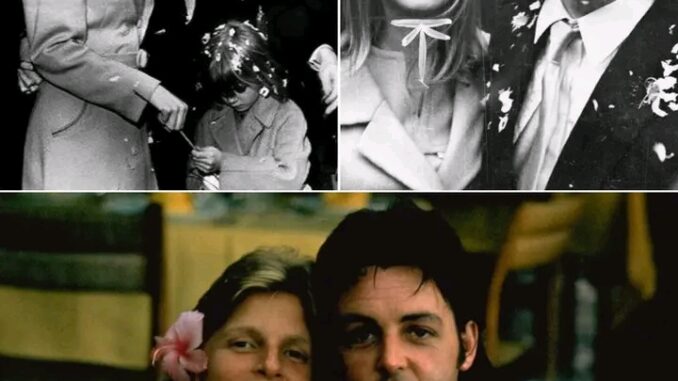
On a gray London morning in 1969, the kind that felt painted in soft ash and stillness, the city stirred with a muted hum. Outside Marylebone Registry Office, the drizzle was gentle but persistent, turning the pavement slick and shining. A small crowd had already gathered—some clutching newspapers, others holding damp flowers, all craning their necks for a glimpse of the man who had, for nearly a decade, been half a heartbeat of the greatest band in the world.
Inside, Paul McCartney and Linda Eastman stood hand in hand, quietly defying expectations. The world outside was roaring with rumors—about breakups, betrayals, and the fading magic of The Beatles. Yet here, away from the tabloid chaos and screaming fans, Paul was making a quiet, human choice. There were no stadiums, no elaborate gowns, no televised ceremony. Just love. Just them.
Paul wore a simple dark suit. His hair, as always, was slightly tousled—more out of habit than style. Linda, elegant in a daisy-printed yellow coat, wore no veil, no designer dress—just grace. Her daughter, Heather, held her hand tightly, unaware of how history would remember this day, only knowing that something important was happening. Beside them were a few family members, close friends, and the registrar. The room was intimate, almost ordinary. But there was magic in the air—the quiet kind that doesn’t demand applause.
Outside, the crowd was growing. Teenagers huddled in raincoats, clutching soggy Beatles records. Older fans stood with arms crossed, shielding themselves from the drizzle and the uncertainty of change. Some wept—tears of happiness, confusion, nostalgia. Others cheered, their cries rising and falling like waves breaking against the gray morning.
When the newlyweds finally emerged, the street erupted—not with the frenzied energy of a concert, but with the raw emotion of people witnessing something real. Linda clutched a small bouquet of freesias and daisies. She looked radiant, not because of makeup or lights, but because she was in love, and it showed in the softness of her smile, the way she leaned into Paul’s side. He, still boyish but weighed by fame, looked toward the crowd with a tenderness that no camera could fully capture. Not the “Cute Beatle.” Not the rock star. Just a man in love.
This wedding, though modest, struck a chord louder than any anthem. In a decade defined by rebellion, freedom, and transformation, Paul and Linda’s union felt like a new kind of revolution. Not one screamed from rooftops, but one whispered in kitchens and back gardens, between people choosing to stay when the world expected them to run.
It wasn’t just about romance—it was about reinvention. Paul, the ever-present face on album covers and teenage bedroom walls, had found an anchor in Linda. She wasn’t a muse in the passive sense; she was a partner, a collaborator, someone who would sit beside him at the piano, camera in hand, heart wide open. She brought New York cool and fierce independence into his world of fame and fatigue. She saw the man before the myth.
Their marriage defied the template of rock stardom. There were no wild affairs or tabloid scandals, no glittering Hollywood detours. Instead, there were long walks on their farm in Scotland, homemade meals, children’s laughter, dogs underfoot, and music made for the joy of it. Together, they created a life where the extraordinary became everyday—and the everyday became sacred.
As the car pulled away from the registry office that morning—an ordinary car, not a limousine—Paul and Linda waved gently to the crowd. No grand speeches. No rehearsed smiles. Just a shared glance between them, quiet and knowing, as if to say: We’ve found it. A kind of peace.
Behind them, the crowd lingered. The drizzle continued. Some fans remained in place, reluctant to let go of the moment. Others drifted off, whispering about the wedding, about what it meant. Not just for Paul, but for the band, for the era, for them. A few skeptics grumbled about the choice—an American photographer? A low-key ceremony? No fanfare? But most felt something stir inside them: hope, perhaps, or a reminder that even amidst the chaos of cultural revolution, simple love stories still mattered.
For Paul and Linda, this was not the end of something. It was the beginning of everything. Over the next three decades, they would raise a family, make music, advocate for animals, and face triumphs and tragedies with a shared resilience. When Linda passed away in 1998, Paul would call her “his guiding light.” And for anyone who ever saw them together, that light had been unmistakable.
Looking back, that rainy morning in London may seem quiet compared to the explosions of Beatlemania. But in its stillness, it echoed with something deeper. Not just fame. Not just love. But courage. The courage to choose something real when illusion was easier. To walk away from spectacle and toward something solid. To hold a hand and say yes—not just to a person, but to a new kind of life.
And so, history did witness a love story that day. Not the loudest. Not the flashiest. But one destined to outshine the noise of an era.
Let me know if you’d like a version with citations, a more journalistic tone, or one with historical photographs and captions.
Leave a Reply